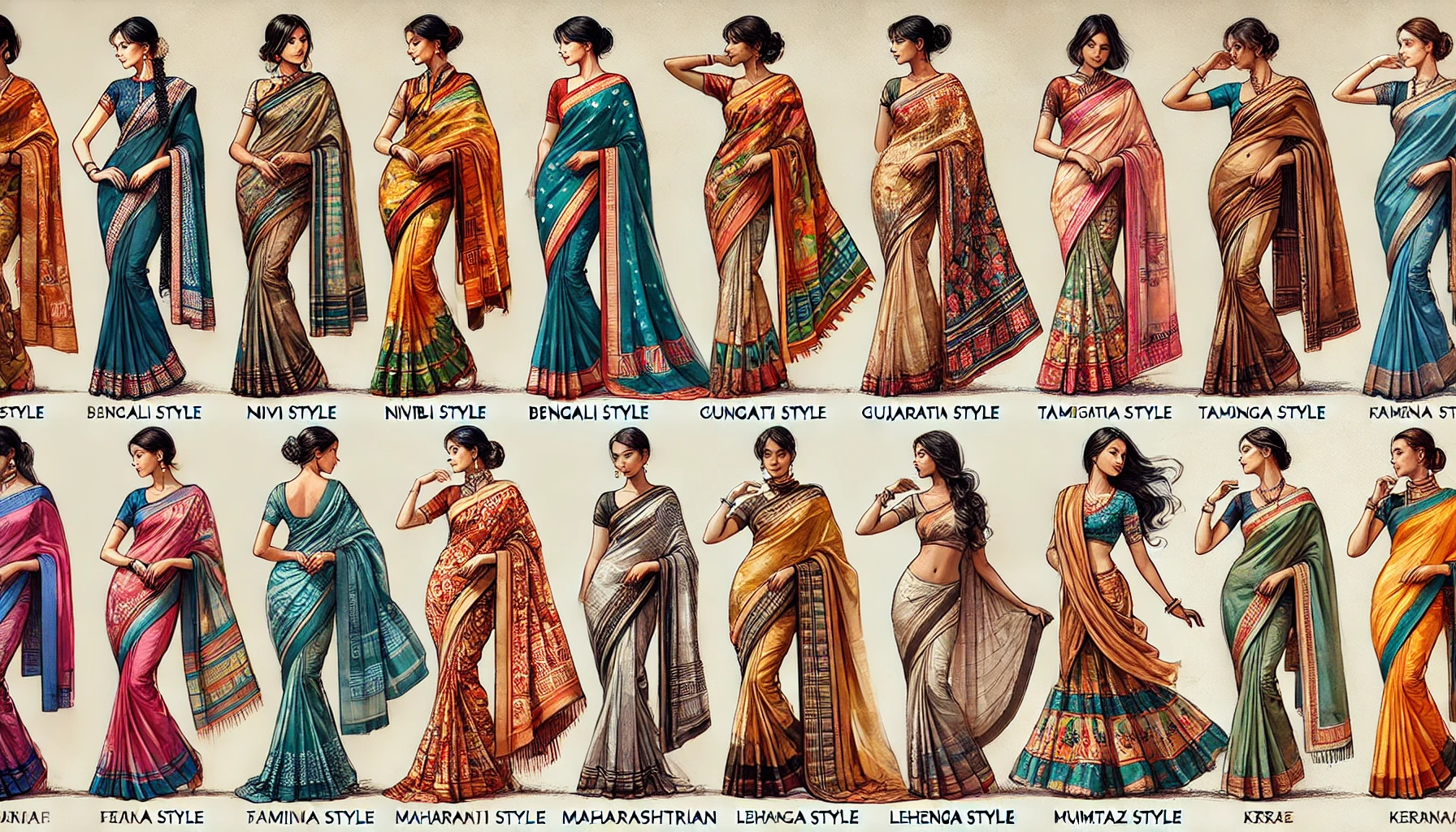Different Types to Wear Saree : Traditional saree wearing style
The saree is more than just a piece of cloth—it’s a cultural symbol, a fashion statement, and a celebration of tradition. Worn by women across South Asia, the saree has transcended generations with its timeless appeal. One of the most fascinating aspects of this attire is its versatility. Depending on the region, occasion, or personal preference, there are various ways to drape a saree, each telling its own story.
Here’s a look at some of the most popular saree draping styles:
1. Nivi Style (Classic Indian Style)
Originating from Andhra Pradesh, the Nivi style is the most commonly worn saree drape across India. This style involves pleating the saree and tucking it into the waist, with the pallu (the loose end of the saree) draped over the left shoulder. Simple yet elegant, the Nivi style is perfect for both everyday wear and special occasions.
Where to wear: This style is versatile and can be worn to work, casual outings, or weddings, depending on the saree material and design.
2. Bengali Style
The Bengali saree drape, made famous by Bollywood, is an iconic look. The saree is wrapped around the waist, with no pleats in the front, and the pallu is draped over both shoulders. The pallu is often left loose or knotted for a more structured look. It’s traditional and regal, often worn during festivals like Durga Puja.
Where to wear: This drape is ideal for cultural festivals, traditional events, and even formal occasions.
3. Gujarati Style
The Gujarati drape is quite similar to the Nivi style but with one key difference—the pallu is brought over the right shoulder instead of the left and spread across the front. This drape is often seen in festive occasions and is perfect for showing off a beautifully embroidered or embellished saree pallu.
Where to wear: Ideal for weddings, garba nights, and festive events.
4. Maharashtrian Style
Inspired by the traditional nauvari saree (nine-yard saree), the Maharashtrian drape has a unique way of being tucked between the legs like a dhoti. This style is often associated with strength and grace, and it’s commonly worn by women during religious festivals and traditional ceremonies.
Where to wear: Perfect for festivals like Ganesh Chaturthi or traditional family functions.
5. Tamilian Style
Similar to the Maharashtrian style, the Tamilian drape also uses a longer saree. The saree is pleated at the front and tucked at the back, with the pallu draped over the shoulder. This style exudes simplicity and tradition and is often worn by brides in Tamil Nadu.
Where to wear: Best suited for weddings, temple visits, and cultural ceremonies.
6. Kerala Style (Mundum Neriyathum)
The Kerala style of draping a saree, known as Mundum Neriyathum, involves a two-piece saree. One piece is wrapped around the waist, while the other is draped over the shoulder. Traditionally worn in a white or cream color with a golden border, this style is a symbol of Kerala’s rich cultural heritage.
Where to wear: Ideal for Onam celebrations, traditional events, and cultural festivals.
7. Lehenga Style
Lehenga style draping is a modern take on the traditional saree. Here, the saree is draped in a way that mimics the appearance of a lehenga—a traditional skirt. The saree is pleated and tucked in such a way that it forms a flared skirt at the bottom, with the pallu draped over the shoulder. This style is glamorous and perfect for a grand occasion.
Where to wear: Ideal for weddings, receptions, and high-profile events.
8. Belted Style
Adding a belt to a saree drape is a contemporary twist to the traditional look. The saree is draped in any of the classic styles, and then a belt is added around the waist to secure the pallu in place. This style is chic, modern, and adds a touch of structure to the saree.
Where to wear: Perfect for fashion-forward events, cocktail parties, or festive celebrations.
9. Mumtaz Style
Inspired by the famous Bollywood actress Mumtaz, this drape style was popularized in the 1960s. The saree is wrapped tightly around the lower body multiple times, creating a layered, mermaid-like look. It’s a retro style that adds a dash of old-school glamour to any event.
Where to wear: Best suited for retro-themed parties, weddings, or glamorous events.
Conclusion
Each saree draping style is a reflection of the region it comes from, the culture it represents, and the occasion it’s worn for. From the elegance of the Nivi style to the regal Bengali drape, there’s a saree style for every event and every woman. Experiment with different styles to find the one that best suits your personality and the occasion.
Whether you’re embracing tradition or putting a modern twist on a classic look, the saree is a timeless garment that allows endless possibilities for creativity and elegance.

